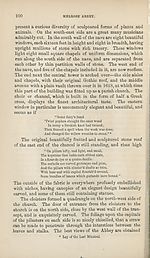Download files
Complete book:
Individual page:
Thumbnail gallery: Grid view | List view

MELROSE ABBEY.
99
MELROSE.
[Hotels: The George; King’s Arms; Railway Hotel.]
Population, 966.
37 miles from Edinburgh, 12 from Jedburgh, and 14 from Kelso.
Melrose is situated on the Tweed, near the base of the Eildon
Hills. The vale of the Tweed is everywhere fertile and beautiful,
and the eye is presented with a wide range of pleasing scenery.
Villages and hamlets, the river winding rapidly among fields
and orchards, the town with its old abbey, wooded acclivities,
and pastoral slopes crowned with the Eildon Hills, form a
richly diversified panorama.
Melrose Abbey is one of the finest specimens of Gothic
architecture in Scotland. The stone of which it is built, though
it has resisted the weather of so many ages, retains perfect sharp¬
ness, so that even the most minute ornaments seem as entire
as when newly wrought. The other buildings being completely
destroyed, the ruins of the church alone remain to attest the
ancient magnificence of this celebrated monastery. It is in
the usual form of a Latin cross, with a square tower in the
centre, eighty-four feet in height, of which only the west side
is standing.
The parts now remaining are the choir and transept—the
west side, and part of the north and south walls of the great
tower, part of the nave, nearly the whole of the southern
aisle, and part of the north aisle. The west gable being in
ruins, the principal entrance is by a richly moulded Gothic
portal in the south transept. Over this doorway is a magnifi¬
cent window, twenty-four feet in height and sixteen in breadth,
divided by four bars or mullions, which branch out or interlace
each other at the top in a variety of graceful curves. The
stone work of the whole window yet remains perfect. Over
this window are nine niches, and two on each buttress, which
formerly contained images of our Saviour and his Apostles.
Beneath the window is a statue of John Baptist, with his eye
directed upward, as if looking upon the image of Christ above.
The carving upon the pedestals and canopies of the niches
exhibits a variety of quaint figures and devices. The buttresses
and pinnacles on the east and west sides of the same transept
H
99
MELROSE.
[Hotels: The George; King’s Arms; Railway Hotel.]
Population, 966.
37 miles from Edinburgh, 12 from Jedburgh, and 14 from Kelso.
Melrose is situated on the Tweed, near the base of the Eildon
Hills. The vale of the Tweed is everywhere fertile and beautiful,
and the eye is presented with a wide range of pleasing scenery.
Villages and hamlets, the river winding rapidly among fields
and orchards, the town with its old abbey, wooded acclivities,
and pastoral slopes crowned with the Eildon Hills, form a
richly diversified panorama.
Melrose Abbey is one of the finest specimens of Gothic
architecture in Scotland. The stone of which it is built, though
it has resisted the weather of so many ages, retains perfect sharp¬
ness, so that even the most minute ornaments seem as entire
as when newly wrought. The other buildings being completely
destroyed, the ruins of the church alone remain to attest the
ancient magnificence of this celebrated monastery. It is in
the usual form of a Latin cross, with a square tower in the
centre, eighty-four feet in height, of which only the west side
is standing.
The parts now remaining are the choir and transept—the
west side, and part of the north and south walls of the great
tower, part of the nave, nearly the whole of the southern
aisle, and part of the north aisle. The west gable being in
ruins, the principal entrance is by a richly moulded Gothic
portal in the south transept. Over this doorway is a magnifi¬
cent window, twenty-four feet in height and sixteen in breadth,
divided by four bars or mullions, which branch out or interlace
each other at the top in a variety of graceful curves. The
stone work of the whole window yet remains perfect. Over
this window are nine niches, and two on each buttress, which
formerly contained images of our Saviour and his Apostles.
Beneath the window is a statue of John Baptist, with his eye
directed upward, as if looking upon the image of Christ above.
The carving upon the pedestals and canopies of the niches
exhibits a variety of quaint figures and devices. The buttresses
and pinnacles on the east and west sides of the same transept
H
Set display mode to:
![]() Universal Viewer |
Universal Viewer | ![]() Mirador |
Large image | Transcription
Mirador |
Large image | Transcription
| Antiquarian books of Scotland > Scotland/Scots > Black's picturesque tourist of Scotland > (159) |
|---|
| Permanent URL | https://digital.nls.uk/130030098 |
|---|
| Description | Thousands of printed books from the Antiquarian Books of Scotland collection which dates from 1641 to the 1980s. The collection consists of 14,800 books which were published in Scotland or have a Scottish connection, e.g. through the author, printer or owner. Subjects covered include sport, education, diseases, adventure, occupations, Jacobites, politics and religion. Among the 29 languages represented are English, Gaelic, Italian, French, Russian and Swedish. |
|---|

